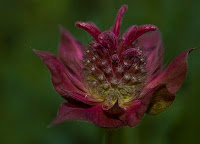 |
| Diamondback Terrapin |
|
A lot of
Historic Rivers Master Naturalists got up early today to help with
Virginia Terp Search 2011. A Virginia Institute of Marine Science (VIMS) graduate student recruited us to canvass the waterways of the Williamsburg area for diamondback terrapins. I was with Team 4 and our territory was (of course!) Queen's Creek from the shores of
New Quarter Park.
 |
| At 7:30 a.m., the deer are abundant. |
According to VIMS, "diamondback terrapins (
Malaclemys terrapin) are the only turtles in the U.S. that live exclusively in brackish saltwater marshes, coastal bays, and lagoons. They range from Cape Cod, Massachusetts to Corpus Christi, Texas, including Chesapeake Bay. Terrapins mainly stay in the water though they can be spotted basking along marsh banks. They are named for the concentric markings and grooves on their shells. They are not sea turtles, but like sea turtles their populations are in trouble. Threats include
drowning in crab pots, habitat loss, nest predation, and boat strikes."
 |
| Osprey |
|
The purpose of the graduate student's work was to conduct a survey that would estimate the species population. Our group can attest to the fact that the terps are in trouble on Queen's Creek. We saw one head bobbing across the stream in 2 1/2 hours of looking. But in any case, time outdoors is never wasted on a Master Naturalist! We saw lots of other critters, starting with herds of deer grazing in most of the park's meadows.
 |
| Great Blue Heron |
When we settled into our first lookout location, we unsettled Mother Osprey on channel marker 15. We tried to keep our eyes on the water, but it was much more fun to watch for glimpses of her young one in the nest. The osprey mom keep us in sight and squealed a cry at us from time to time just to let us know she was paying attention.
 |
| A little crab sex? |
Right around the corner, the pine trees provided nesting space for Great Blue Herons. They called, flew, and landed to look for snacks in the marsh beside us. Now remember, we were looking for terrapins. Really! And it was at this location that we saw our one and only of the day. Just a head poking out of the water. We were pretty sure it was a terp.
 |
| Fiddler Crab |
At our next station the beach was hopping with fiddler crabs. As I looked behind the reeds for terp nests, eggs, or footprints, I caught a couple of fiddlers going for it. The female is on top. The male grabbed her from behind and somehow they ended up in this position. Next I came across a fiddler with the biggest fighting claw I'd ever seen. Okay, little fellow, I see you all ready!
 |
| Sunday morning paddle |
While we were at station 1 we saw a couple of homo sapiens board a canoe and take it for a spin on Cub Creek, a tributary of Queen's. Later, we saw them again at station 2 on Queen's Creek and one more time at station 3 at the New Quarter Park floating dock, where I snapped this.
 |
| Mud toad! |
People watching continued to be good at the floating dock where we watched a father and son fishing. They pulled up a croaker, several oyster shells, and a mud toad while we were there. The dad told us that his son has been crazy about fishing since getting a rod and reel for his birthday. The kid's a little ham, I might add.
 |
| Northern Watersnake |
And to cap the day off, we were excited to see just one more extra special species: a northern watersnake! Don't worry, it's not poisonous. People sometimes think it's a water moccasin, but you can tell them apart by their beady little eyes. That's the sort that non-venomous snakes have while poisonous snakes have slitty eyes.
Well, so we didn't see much of our target species, but the morning was just fine, all in all. The temperatures were in the 70s and sun was peeking in and out behind the clouds. Like I said, time outdoors is never wasted on a Master Naturalist.





















